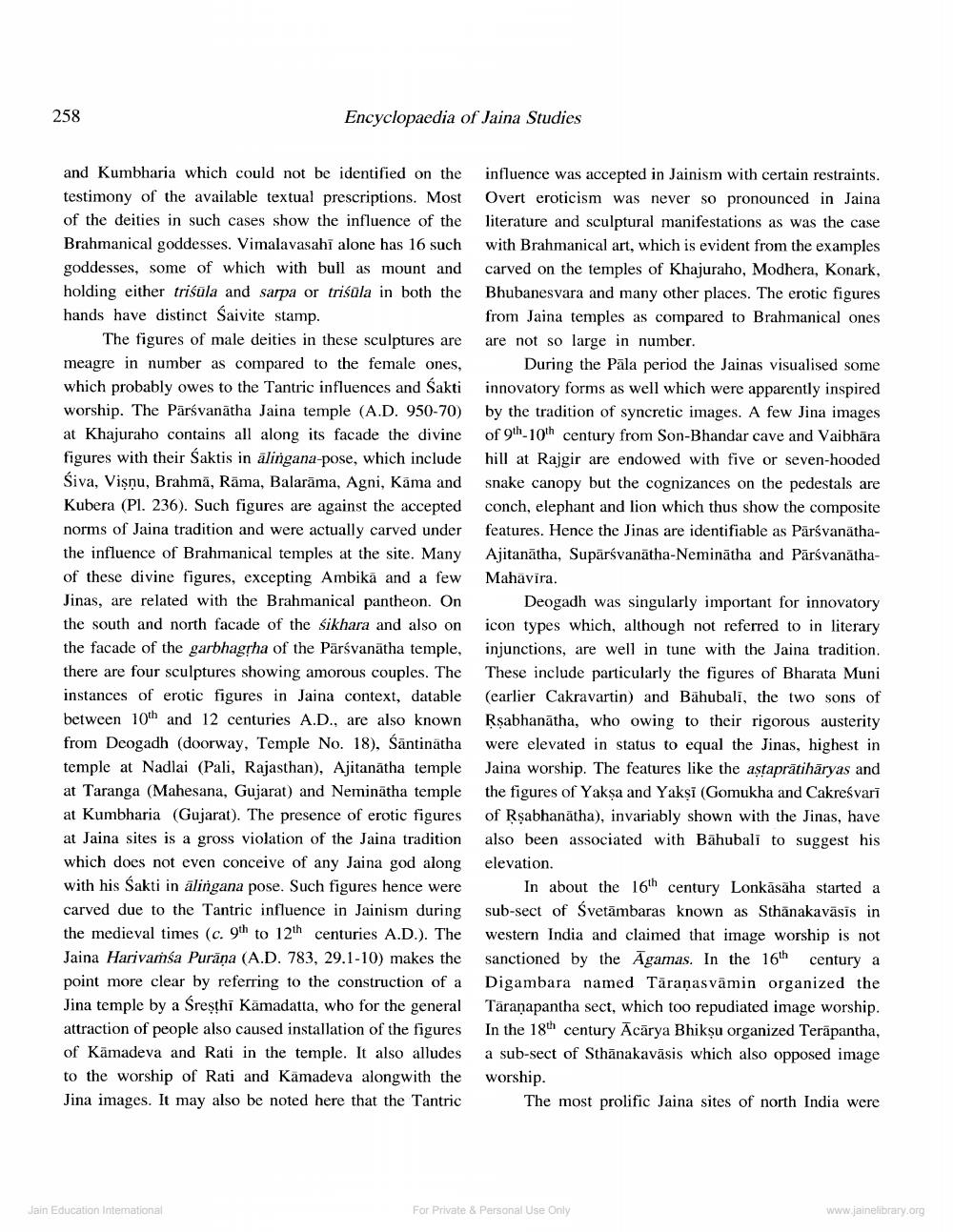________________
258
Encyclopaedia of Jaina Studies
and Kumbharia which could not be identified on the testimony of the available textual prescriptions. Most of the deities in such cases show the influence of the Brahmanical goddesses. Vimalavasahi alone has 16 such goddesses, some of which with bull as mount and holding either trisula and sarpa or trisula in both the hands have distinct Saivite stamp
The figures of male deities in these sculptures are meagre in number as compared to the female ones, which probably owes to the Tantric influences and Sakti worship. The Pārsvanātha Jaina temple (A.D. 950-70) at Khajuraho contains all along its facade the divine figures with their Śaktis in alingana-pose, which include Śiva, Vişnu, Brahma, Rāma, Balarāma, Agni, Kāma and Kubera (P1. 236). Such figures are against the accepted norms of Jaina tradition and were actually carved under the influence of Brahmanical temples at the site. Many of these divine figures, excepting Ambikā and a few Jinas, are related with the Brahmanical pantheon. On the south and north facade of the śikhara and also on the facade of the garbhagha of the Parsvanātha temple, there are four sculptures showing amorous couples. The instances of erotic figures in Jaina context, datable between 10th and 12 centuries A.D., are also known from Deogadh (doorway, Temple No. 18), Santinātha temple at Nadlai (Pali, Rajasthan), Ajitanātha temple at Taranga (Mahesana, Gujarat) and Neminātha temple at Kumbharia (Gujarat). The presence of erotic figures at Jaina sites is a gross violation of the Jaina tradition which does not even conceive of any Jaina god along with his Sakti in alingana pose. Such figures hence were carved due to the Tantric influence in Jainism during the medieval times (c. 9th to 12th centuries A.D.). The Jaina Harivamsa Purāņa (A.D. 783, 29.1-10) makes the point more clear by referring to the construction of a Jina temple by a Sreşthi Kāmadatta, who for the general attraction of people also caused installation of the figures of Kamadeva and Rati in the temple. It also alludes to the worship of Rati and Kamadeva alongwith the Jina images. It may also be noted here that the Tantric
influence was accepted in Jainism with certain restraints. Overt eroticism was never so pronounced in Jaina literature and sculptural manifestations as was the case with Brahmanical art, which is evident from the examples carved on the temples of Khajuraho, Modhera, Konark, Bhubanesvara and many other places. The erotic figures from Jaina temples as compared to Brahmanical ones are not so large in number.
During the Pāla period the Jainas visualised some innovatory forms as well which were apparently inspired by the tradition of syncretic images. A few Jina images of 9th 10th century from Son-Bhandar cave and Vaibhāra hill at Rajgir are endowed with five or seven-hooded snake canopy but the cognizances on the pedestals are conch, elephant and lion which thus show the composite features. Hence the Jinas are identifiable as PārsvanathaAjitanätha, Supärsvanatha-Neminātha and PārsvanathaMahavira.
Deogadh was singularly important for innovatory icon types which, although not referred to in literary injunctions, are well in tune with the Jaina tradition. These include particularly the figures of Bharata Muni (earlier Cakravartin) and Bahubali, the two sons of Rsabhanātha, who owing to their rigorous austerity were elevated in status to equal the Jinas, highest in Jaina worship. The features like the astaprātihāryas and the figures of Yaksa and Yaksi (Gomukha and Cakreśvarī of Rşabhanātha), invariably shown with the Jinas, have also been associated with Bahubali to suggest his elevation.
in about the 16th century Lonkāsāha started a sub-sect of Svetämbaras known as Sthanakavāsis in western India and claimed that image worship is not sanctioned by the Āgamas. In the 16th century a Digambara named Taranasvamin organized the Tāraṇapantha sect, which too repudiated image worship. in the 18th century Acārya Bhikṣu organized Teräpantha, a sub-sect of Sthänakaväsis which also opposed image worship.
The most prolific Jaina sites of north India were
Jain Education Intemational
For Private & Personal Use Only
www.jainelibrary.org




